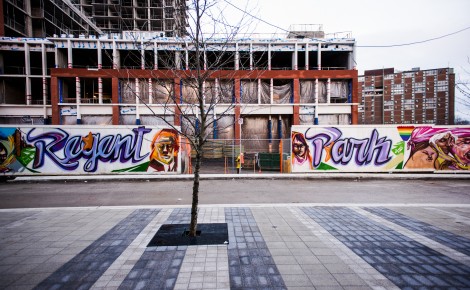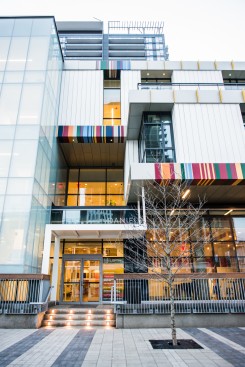Britta Badour and I stand at the corner of Dundas and River as she gives me advice on traveling through Regent Park: “They say that you should never walk up River from Queen to Gerrard, unless you want to get jumped.” Badour laughs, obviously half-joking. But there is an undercurrent of caution to her words.
Regent Park was built in the late 1940s as part of an initiative to provide affordable, high-density housing for families living on social assistance. Over the years, it has become a hub for new immigrants to the city, and remains the area with the highest concentration of people living on social assistance programs in Toronto’s downtown core.
As it matured, the neighbourhood developed a reputation for drug use and crime, becoming a no-go area for many Torontonians living outside it. This was partly a reaction to real crimes that were being committed in the area. However, it was also based on assumptions and prejudices about the types of people living there.
As a result of this stigma, Regent Park remained relatively untouched by redevelopment until 2005 when the Toronto Community Housing Corporation (TCHC), in partnership with City Council, began work on the Regent Park Revitalization project. The project is a $1 billion, 15-year initiative to redevelop the area that aims to mix community housing with both affordable and luxury housing units, turning the area into a mixed-income neighbourhood to promote the mixing of socio-economic groups, and to make the area safer and more accessible for all residents and visitors.

Despite the Revitalization, the generally impression of Regent Park is still quite confused, uninformed, and guided by stigma and prejudice. In order to gain a clear image of Regent Park today — seven years into the redevelopment — I sought the help of spoken-word poet and resident Badour. Badour showed me around the neighbourhood, explaining what the area means to its residents and how the Revitalization is affecting the local culture.
As we walk up Sackville Street, which has now been extended to cut through the entire neighbourhood, Badour describes her first few weeks in the area:
“I’ve been living in Regent Park now for almost four years. I first moved in over on River and I was really scared ’cause in the first two weeks that I was living there, there were three shootings,” she remembers. “It was pretty wild. So I was like a little bit freaked out. But that’s been probably the biggest negative thing that’s happened in the area since I’ve lived here.”
I comment on the general view that Regent Park is a dangerous neighbourhood, and ask Badour whether this impression is based on fact or not.
“Regent Park has that stigma, I guess you could say. It has a very bad rep’. But like I’ve said, for living here for the past four years it’s such a good community… I love living here,” Badour explains. “The people you see out here are pretty much people you see every time you step out of your house. And they give love and you give love back or you just go on your merry way [laughs]. I feel like that’s the way it should be in a community, in a neighbourhood or whatever.”
Sackville Street is flanked by open fields where low-rise housing units used to stand. Just beyond the field sits Nelson Mandela Park Public School, which is set to reopen on March 19, after more than a year of extensive remodeling and renovations. We continue our walk up to the Daniels Spectrum, known locally as the Art Box, which has become the new cultural and artistic hub of the neighbourhood. The Spectrum is a free space where after school programs are organized by volunteers, and large cultural
events take place.
This summer the Art Box was the site of the Manifesto Hip-Hop festival, an annual festival intended to promote local artists as well as music on a global scale. Badour noted that hosting Manifesto was really important for the community. “Manifesto is the biggest rap and hip-hop festival in Toronto… Having Manifesto has drawn a lot of attention to Regent Park as well, which has helped the community programs.”
 The organizers of the festival wanted to host it in Regent Park in the past, but were unable do so because of the widespread demolition and construction projects in progress until recently. It was only this year that the infrastructure for such an event arrived.
The organizers of the festival wanted to host it in Regent Park in the past, but were unable do so because of the widespread demolition and construction projects in progress until recently. It was only this year that the infrastructure for such an event arrived.
Upstairs in the Art Box are conference rooms, offices, and classrooms where after-school programs are held. The lobbies of both the first and second floor are filled with paintings and photographs mostly by local artists, some of who are friends of Badour’s. The new community centre is important, but Badour says that it’s the volunteers that make the programs what they are. “The thing that I really love is that the people who live here, they really leave their footprint, you know?”
What about concerns that these people might be pushed out as new, more affluent tenants move in? “I don’t think that’s happening,” Badour says. “I think that was a concern for a lot of people when they were living here while things were being torn down, but for me it feels like it’s becoming more of a family-based place and like young professionals — that kind
of living space.”
Walking west on Dundas from the Art Box, we see the new aquatic complex, which features a full gym and a regulation size Olympic pool. Although membership costs money, the rates are extremely low compared to similar centres. Talking about how quickly the pool was built Britta laughs, saying, “I was reading that back in the sixties they basically wanted to raise money to build a pool in Regent Park, and so they fought hard to add two dollars a month to their rent and it took 17 years to raise $17,000 to start putting a centre together for a pool. That was like back in the sixties, and now look at it.”

During the walk Badour has been carrying a sign that reads “I Have A Story,” which she explains the significance of. After moving into the area Badour got involved with a program called Put Food In The Budget, aiming to provide sufficient funds for people on social assistance programs to afford food. “They don’t have money to even about food once their rent is paid,” says Badour. “And so especially living in an area like Regent Park where people do have subsidized housing and they do have government assistance, that for me was something I wanted to connect to personally … also on behalf of those who live in areas like this all over the world and don’t really have the voice to speak out on it.
“I put together something called ‘I Have A Story’ with the help of three other poets, and what I realized, just talking to people who live on social assistance programs, is that we all do have a story. I wanted to bring light and power to people’s voices.”

Walking from the developing area into the old part of the neighbourhood, Badour tells me about rumours that the name of the area will be changed to Research Park. “I don’t know if it’s a joke or whatever,” Badour says.
To change the name would go too far in erasing what Regent Park once was, and still is, in part. To erase the name of a place is to wipe out its history, and despite its negative reputation, Regent Park is an important part of the city’s history. This is not only felt in the rumoured changing of the name, but also in the physical destruction of the buildings with their many murals and the history that they represent.
On one of the last single-story housing sections in Regent Park is a large mural listing statistics on pregnancy and sti transmission in the neighbourhood, and promoting safer sex. It’s a stark reminder that simply replacing the old buildings with taller, shinier glass versions will not fix the many problems that exist in Regent Park. Although living arrangements will improve, there will still be almost 3,000 people in Regent Park who live on social assistance and who, after paying their rent, have little left to buy food and other necessities. Putting rich and poor together and hoping that it will improve things, although an intriguing idea, may not cause a staggering change in these people’s day to day lives, nor will it necessarily put them in better positions to provide for themselves and their families.

Despite the clear problems that still exist in Regent Park, there is a sense that the neighbourhood has a strong cultural life and a community bond that exists in few other areas of Toronto. People still seem to help each other out and get involved in improving their surroundings and educating the younger generations — something to be envied and emulated. Moreover, Regent Park does not self-consciously claim to be an artistic area, yet experiencing the neighbourhood through Badour’s guidance I saw and heard about more art and art-related events than in any other area of Toronto — even more than downtown areas claim to be centers of creativity. Regent Park is a vibrant neighbourhood that is often ignored, but seems to be on the edge of doing and creating some very interesting and important things, culturally and socially. The hope is that the Revitalization will facilitate positive change and growth rather than washing away the local flavour and gentrifying it entirely. But the neighbourhood remains in flux and sporadic crime is still a reality.
Badour finished the tour with a few words about her hopes for Regent Park’s future.
“I think that people in this community have a chance to have their say, and whatever goals they have in mind, now they have the opportunity to actually fulfill and to accomplish with their community. That’s what I really love about being here, because it’s so young and vibrant in culture that I have a lot of appreciation for it… I don’t know man, young people and family culture, that’s kind of how I see, like how I vibe with things right now. I have a lot of hope, I see a lot of good things coming out of this development especially with the way things are right now, I don’t have any negative comments on it whatsoever.
I think we’re gonna grow, expand more and more into our awareness of how each of us does have the opportunity to do what we want with our communities.”


